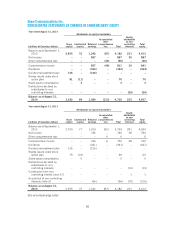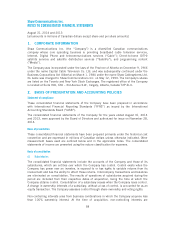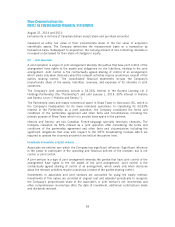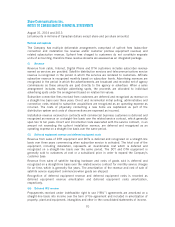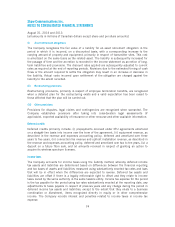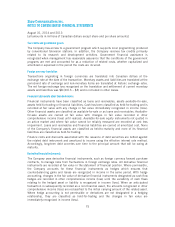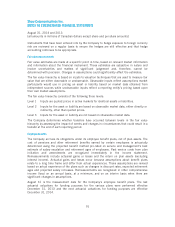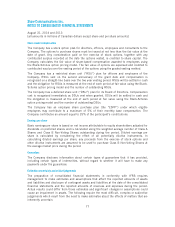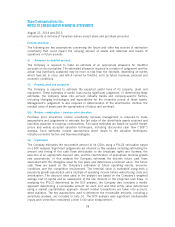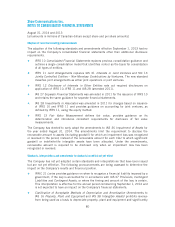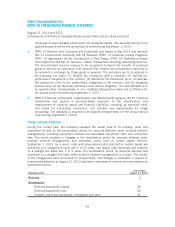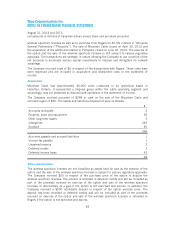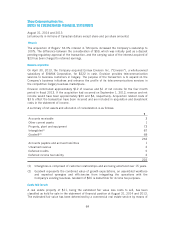Shaw 2014 Annual Report Download - page 78
Download and view the complete annual report
Please find page 78 of the 2014 Shaw annual report below. You can navigate through the pages in the report by either clicking on the pages listed below, or by using the keyword search tool below to find specific information within the annual report.Shaw Communications Inc.
NOTES TO CONSOLIDATED FINANCIAL STATEMENTS
August 31, 2014 and 2013
[all amounts in millions of Canadian dollars except share and per share amounts]
(i) Asset retirement obligations
The Company recognizes the fair value of a liability for an asset retirement obligation in the
period in which it is incurred, on a discounted basis, with a corresponding increase to the
carrying amount of property and equipment, primarily in respect of transmitter sites. This cost
is amortized on the same basis as the related asset. The liability is subsequently increased for
the passage of time and the accretion is recorded in the income statement as accretion of long-
term liabilities and provisions. The discount rates applied are subsequently adjusted to current
rates as required at the end of reporting periods. Revisions due to the estimated timing of cash
flows or the amount required to settle the obligation may result in an increase or decrease in
the liability. Actual costs incurred upon settlement of the obligation are charged against the
liability to the extent recorded.
(ii) Restructuring provisions
Restructuring provisions, primarily in respect of employee termination benefits, are recognized
when a detailed plan for the restructuring exists and a valid expectation has been raised to
those affected that the plan will be carried out.
(iii) Other provisions
Provisions for disputes, legal claims and contingencies are recognized when warranted. The
Company establishes provisions after taking into consideration legal assessments (if
applicable), expected availability of insurance or other recourse and other available information.
Deferred credits
Deferred credits primarily include: (i) prepayments received under IRU agreements amortized
on a straight-line basis into income over the term of the agreement, (ii) equipment revenue, as
described in the revenue and expenses accounting policy, deferred and amortized over three
years to five years, (iii) connection fee revenue and upfront installation revenue, as described in
the revenue and expenses accounting policy, deferred and amortized over two to ten years, (iv) a
deposit on a future fibre sale, and (v) amounts received in respect of granting an option to
acquire its wireless spectrum licenses.
Income taxes
The Company accounts for income taxes using the liability method, whereby deferred income
tax assets and liabilities are determined based on differences between the financial reporting
and tax bases of assets and liabilities measured using substantively enacted tax rates and laws
that will be in effect when the differences are expected to reverse. Deferred tax assets and
liabilities are offset if there is a legally enforceable right to offset and they relate to income
taxes levied by the same authority in the same taxable entity. Income tax expense for the period
is the tax payable for the period using tax rates substantively enacted at the reporting date, any
adjustments to taxes payable in respect of previous years and any change during the period in
deferred income tax assets and liabilities, except to the extent that they relate to a business
combination or divestment, items recognized directly in equity or in other comprehensive
income. The Company records interest and penalties related to income taxes in income tax
expense.
74




